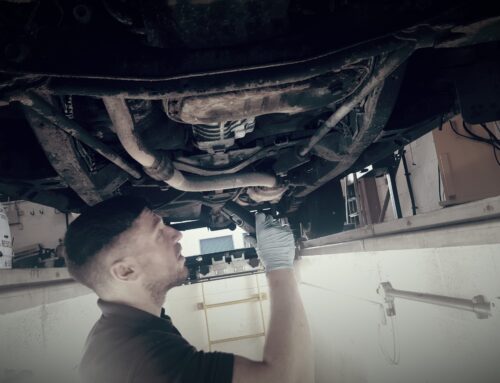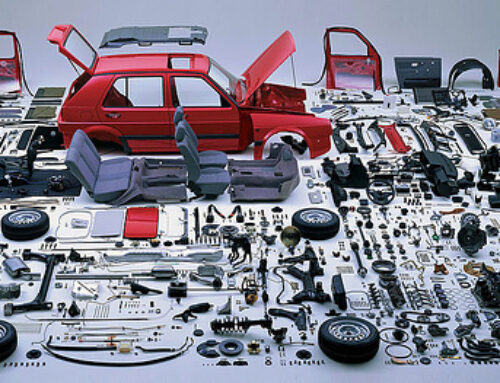Read our quick guide to dashboard warning lights to understand some common vehicle faults and potential solutions
Everyone’s different. Some people will bring a car into us as soon as a warning light appears on the dashboard. Others will keep their dashboard lit up like a Christmas tree and ignore the signs of a fault for as long as they can.
Of course, you should always investigate the cause of a warning light. Getting to know what they mean is the first step, as some things are easily corrected even without the need of a garage. Read our guide to learn more about the dashboard warning lights and what to do when they are illuminated.
How do warning lights work?
When you start your car, you will notice the lights on the dash come on all together. This is to check that all the bulbs and connected components are working as they should.
These should turn off after a few seconds, but if one or more stay illuminated, it is to warn of potential problem.
Warning lights can also come on whilst driving. If this happens, depending on the colour and icon displayed, you may have to pull over and investigate at your first safe opportunity to do so.
What do the different coloured warning lights mean?
Some warning lights have a traffic light colour code to denote the importance of a warning light.
A red warning light means you should pull over and turn the engine off as soon as possible. You should call for assistance from a professional.
If a yellow light is displayed, you should take extra care and got it checked out as soon as possible.
A green light is used for information an requires no immediate action by the driver.
What do dashboard warning lights mean?
Below are some of the common dashboard warning lights that require your attention:
Engine management light
Also referred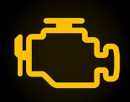 to as the ECU or check engine light, this could mean a variety of things but ignoring it could lead to further damage. It may be accompanied by noticeable signs of a problem such as lack of power, but whether it turns out to be a simple issue such as an unsecured fuel cap or a more serious problem like a catalytic converter fault, you should get it checked out professionally straight away.
to as the ECU or check engine light, this could mean a variety of things but ignoring it could lead to further damage. It may be accompanied by noticeable signs of a problem such as lack of power, but whether it turns out to be a simple issue such as an unsecured fuel cap or a more serious problem like a catalytic converter fault, you should get it checked out professionally straight away.
Brake warning light
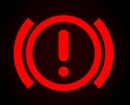 This can let you know that your parking brake is left on or be a sign of a more serious safety issue. If an applied handbrake isn’t the problem, this could signal issues such as low brake fluid, a faulty wear sensor or a more serious fault. If it’s accompanied by any noticeable change in how the brake pedal feels or reacts, it could signify a serious safety issue that needs to be addressed immediately.
This can let you know that your parking brake is left on or be a sign of a more serious safety issue. If an applied handbrake isn’t the problem, this could signal issues such as low brake fluid, a faulty wear sensor or a more serious fault. If it’s accompanied by any noticeable change in how the brake pedal feels or reacts, it could signify a serious safety issue that needs to be addressed immediately.
Engine temperature/ coolant level warning
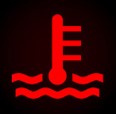 This will illuminate red if there is signs of the engine overheating, so you need to address this immediately. If the coolant level is low the light would likely illuminate yellow first to warn you to top up. However, a red light could be a sign of potentially more serious issues such as a leak or head gasket failure. Overheating can cause irreparable engine damage so needs to be taken seriously.
This will illuminate red if there is signs of the engine overheating, so you need to address this immediately. If the coolant level is low the light would likely illuminate yellow first to warn you to top up. However, a red light could be a sign of potentially more serious issues such as a leak or head gasket failure. Overheating can cause irreparable engine damage so needs to be taken seriously.
Tyre pressure warning light
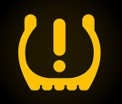 A fairly self-explanatory warning to check your tyre pressure, this could also signify a puncture and provides an importance maintenance reminder. You should always ensure your tyres are at the recommended pressure for safety reasons. However, if your tyre pressure is fine this could signal a faulty sensor or even be the result of cold weather and its effects on air pressure, in which case a drive to warm the tyres should rectify it.
A fairly self-explanatory warning to check your tyre pressure, this could also signify a puncture and provides an importance maintenance reminder. You should always ensure your tyres are at the recommended pressure for safety reasons. However, if your tyre pressure is fine this could signal a faulty sensor or even be the result of cold weather and its effects on air pressure, in which case a drive to warm the tyres should rectify it.
Engine oil warning light
 This light will come on if the oil temperature is too high or the oil level is too low. You should regularly check your oil as if it is not lubricating the engine enough it could mean costly repairs or even irreparable damage. You should check for obvious signs of oil leaks and take to your vehicle into a garage if topping up the oil does not turn the light out.
This light will come on if the oil temperature is too high or the oil level is too low. You should regularly check your oil as if it is not lubricating the engine enough it could mean costly repairs or even irreparable damage. You should check for obvious signs of oil leaks and take to your vehicle into a garage if topping up the oil does not turn the light out.
Battery warning light
 This is a warning that your car battery is not charging whilst driving. There can be several reasons for this, such as a faulty alternator, battery or even damaged wiring, so it’s best to get this checked out quickly so you don’t get stranded anywhere with a flat battery.
This is a warning that your car battery is not charging whilst driving. There can be several reasons for this, such as a faulty alternator, battery or even damaged wiring, so it’s best to get this checked out quickly so you don’t get stranded anywhere with a flat battery.
Electronic stability control warning light
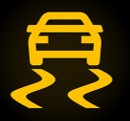 ESC – or alternatively ESP (electronic stability problem) – relates to your vehicle’s automatic traction control system. If it flashes whilst driving it means the system is intervening – for example, if you’re driving in slippery conditions. If it stays illuminated, it means there may be a problem with the system. As this is an important safety feature you should take it to a garage if this occurs
ESC – or alternatively ESP (electronic stability problem) – relates to your vehicle’s automatic traction control system. If it flashes whilst driving it means the system is intervening – for example, if you’re driving in slippery conditions. If it stays illuminated, it means there may be a problem with the system. As this is an important safety feature you should take it to a garage if this occurs
Warning lights such as the last one can be vehicle-specific, with the technology in cars always evolving. You should always familiarise yourself with the vehicle handbook when you get a new car. This will help you to understand the possible cause of any fault and allow you to address issues accordingly.
You should never ignore a warning light, even if there seems to be no performance issues with your vehicle. Faulty sensors are also a problem the need fixing quickly, as it can mean that important safety features are not in use.
Here at OTRA we have the latest diagnostic equipment to diagnose any fault and can provide a full report and solution. Call in for a diagnostic check when warning lights occur for peace of mind and to ensure your vehicle is in top condition.


